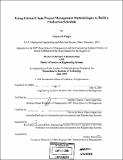| dc.contributor.advisor | Stephen C. Graves and Oliver [i.e. Olivier] de Weck. | en_US |
| dc.contributor.author | Poppe, Clayton D. (Clayton Douglas) | en_US |
| dc.contributor.other | Leaders for Manufacturing Program. | en_US |
| dc.date.accessioned | 2009-11-06T16:35:00Z | |
| dc.date.available | 2009-11-06T16:35:00Z | |
| dc.date.copyright | 2009 | en_US |
| dc.date.issued | 2009 | en_US |
| dc.identifier.uri | http://hdl.handle.net/1721.1/49785 | |
| dc.description | Thesis (M.B.A.)--Massachusetts Institute of Technology, Sloan School of Management; and, (S.M.)--Massachusetts Institute of Technology, Engineering Systems Division; in conjunction with the Leaders for Manufacturing Program at MIT, 2009. | en_US |
| dc.description | Includes bibliographical references (p. 110). | en_US |
| dc.description.abstract | Critical Chain project management methodologies have been used for the last ten years to manage a wide range of projects. These methods, which apply Eli Goldratt's Theory of Constraints, have demonstrated the ability to complete projects faster and with greater predictability. While the focus of Critical Chain has been on projects of a finite duration, such as product development efforts, the application of these techniques in a more continuous, manufacturing setting can also bring about the same benefits of decreased time and increased predictability. In a customized product environment, where each product is a unique project, scheduling production requires more than the creation of a schedule and the management of manufacturing resources. Information must be created and managed from the moment a project is initiated through its implementation. It is the proper management of the essential project details across functions: materials, labor activities, and their timing, that enables faster project lead times and lower overall costs. ABB Raffin Electric's labor and material costs were 15% higher than expected for 2008 due to cost and schedule slippage. This thesis shows how a process for managing project information could have recovered 75% of the lost costs through the proper management of materials and labor activities. Costs and activity durations were estimated using a tool that combined small, common groups of materials and labor activities into complex assemblies. | en_US |
| dc.description.abstract | (cont.) These assemblies were then translated into a set of common instructions for execution. A Critical Chain production schedule managed the execution of these work instructions and balanced resources among all active projects. Finally, a process for feeding back information from finished projects enabled more accurate future estimates. | en_US |
| dc.description.statementofresponsibility | by Clayton D. Poppe. | en_US |
| dc.format.extent | 110 p. | en_US |
| dc.language.iso | eng | en_US |
| dc.publisher | Massachusetts Institute of Technology | en_US |
| dc.rights | M.I.T. theses are protected by
copyright. They may be viewed from this source for any purpose, but
reproduction or distribution in any format is prohibited without written
permission. See provided URL for inquiries about permission. | en_US |
| dc.rights.uri | http://dspace.mit.edu/handle/1721.1/7582 | en_US |
| dc.subject | Sloan School of Management. | en_US |
| dc.subject | Engineering Systems Division. | en_US |
| dc.subject | Leaders for Manufacturing Program. | en_US |
| dc.title | Using critical chain project management methodologies to build a production schedule | en_US |
| dc.type | Thesis | en_US |
| dc.description.degree | S.M. | en_US |
| dc.description.degree | M.B.A. | en_US |
| dc.contributor.department | Leaders for Manufacturing Program at MIT | en_US |
| dc.contributor.department | Massachusetts Institute of Technology. Engineering Systems Division | |
| dc.contributor.department | Sloan School of Management | |
| dc.identifier.oclc | 457224257 | en_US |
